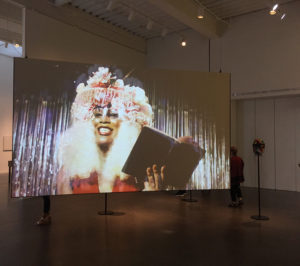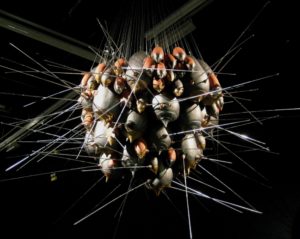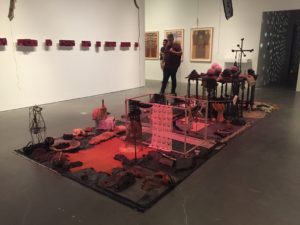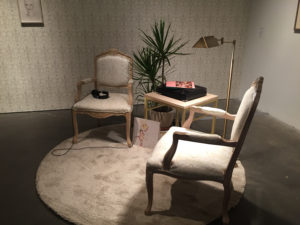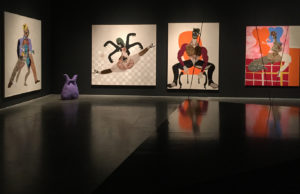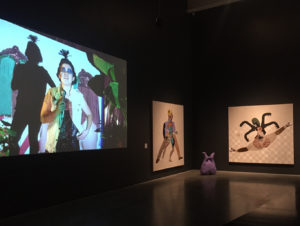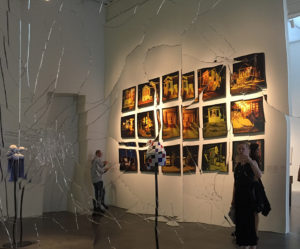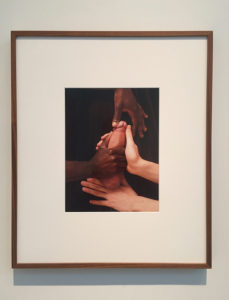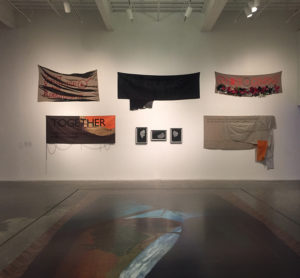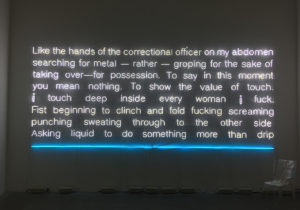“The New Museum presents “Trigger: Gender as a Tool and a Weapon,” a major exhibition investigating gender’s place in contemporary art and culture at a moment of political upheaval and renewed culture wars. The exhibition features an intergenerational group of artists who explore gender beyond the binary to usher in more fluid and inclusive expressions of identity. Occupying the three main floors of the New Museum, the exhibition is on view from September 27th, 2017 to January 21, 2018.” – New Museum
The elevator opened to a gothic horror set: costuming, glossy black, sound stage, decadent weapons.
“I’m here alone.” The voice of Werner Hirsch, a drag queen from the video Toxic, fills the painted black room populated with sculpture. She’s fed up. She’s not having it at all. Pointing behind the camera she observes, “…there are 1,2,3,4 people over there …” My first moment with “Trigger: Gender as a Tool and a Weapon” — and the Brechtian 4th wall is smashed like a mirror.
The queen digs in further, “…you’re doing the work of a police woman,” she says to the interviewer. Toxic, an installation with Super 16mm film transferred to HD, LED lights, stage, artificial hair, curtain, by Pauline Boudry and Renate Lorenz, reverberates, altering the objects of the 4th floor.
Signs and Grips, an installation by Simone Leigh, renders feminine symbols of comfort dysfunctional, and therefore menacing. Cupboard VII, a massive hut made of steel and raffia, is a shelter that no one can enter. Pressed into the corner, I assume its entrance faces the wall. The thought of an opening existing, but refusing, was frustrating: a thwarted desire to penetrate. Curiosity becomes an excuse for invasion at times. But, Cupboard VII won.
Above the hut, a collection of antenna-pierced breasts suspend from the ceiling. I can’t go inside the house. I can’t touch the breasts. Are the objects evil? Or am I terribly needy? Why do you refuse me, sculpture? Antennae act as the weapon used to stab the breasts but also make them conductive. These sculptures are rebelling and transfigured. Instead of a chandelier, trophallaxis is a spaceship from an Afrofuture sent to bathe us—though not in light. Not its job to.
On the other side of the room, Toxic’s LED lights make a pseudo-screen through which to view Tschabalala Self’s paintings. Past the props and close to the paintings, pieces of fabric are sutured together to create the figures of Floor Dance, Mane and Loner. As my eye moved along these stitches, a voice from Toxic began listing various drugs and chemicals, “…estrogen, heroin, ecstasy, testosterone…” We may alter with stitches, performance, or chemicals. It’s fluid and available. Speech from video lingers on sculpture, exposing doubles to topple over anything stable.
Nothing is stable. Marsha “Pay it no Mind” Johnson AKA “Saint Marsha” is portrayed in Lost in the Music, an HD video installation by Reina Gossett and Sasha Wortzel. Marsha Johnson is introduced on a tinsel-dripping stage as the “Saint of Christopher Street.” After applause, she begins to recite her poem, declaring over and over, “I am not a saint.” Archived footage and reenactment are spliced together. The back of the screen is a cracked mirror – harkening Stonewall. In the reflection, I became disjointed alongside the Edge of Twilight, a wall of photography by Connie Samaras. The already strangely-lit homes featured in the photographs became more distorted in the mirror. Haunted house. Suburban horror. Get off the lawn of smashed ornaments. Run.
Symbols of Americana skew playfully. Stanya Kahn’s video, It’s Cool, I’m Good, features a performer who has sustained ambiguous injuries from an unknown accident or assault. Completely bandaged, doing crutches and a pink hospital gown, Kahn goes about trying to have a regular day in California. Their antics were hilarious, then frustrating. As I laughed, I couldn’t help but ricochet into a series of anxiety-produced questioning: What happened to you? Did someone do this to you? Is it because of your gender ambiguity? Did someone bash you? Please tell. You keep making me laugh instead of answering my questions. Watching you eat is funny as you spill. When you explain protective habits of animals, flies swarm your hospital gown and crawl all over your maybe-delicate spine. Are your wounds subject to infection? Is being on the beach even OK in your condition? Is this real? I’m concerned.
The piece differentiates itself from other works in the show, most of which utilize fantasy and lushness as political rebellion. The constant question – Is this real? – presents Kahn’s drag as a bandaged slapstick nightmare that eats fast food, babbles, and rides a motorcycle.
I can’t stay in Kahn’s world for long. Compassion fatigue causes concern to wane. I’m sorry. I’m not a saint. I have to go, but I’m not going cleanly. The Mauve Decade instructs in knitted pink, “vacuum house frequently.” I disagree. In “Trigger,” nothing is a vacuum. Nothing gets sucked away. There are no clear boundaries between these art objects – filthy. The pieces have the ability to fuse and alter one another. They cut each other up and sew each other back to being. Physical cuts, stitches and weaves, as in Tschabalala Self’s paintings, The Mauve Decade and Troy Michie’s cut found magazine pieces populate “Trigger.”
Diamond Stingly’s disembodied braid appears on each floor of the museum, suggesting that inside the walls, something is living. The icky feeling fades into relief. Wouldn’t it be grand if the museum was invaded from the inside out? Ripped open to show hair and tissue. Oh, the horror. The dead white walls are oozing, dear.
I descend like the braid, and find the Cave of Secrets. In opposition to Leigh’s hut, Liz Collins’ installation plays mother horror-host. I finally got to enter. Thank hell. I felt like I was in a body, something squishy. All of that fabric and leather had breathing capabilities. Leather Wall looked as if it could have trickled blood, like in Amityville Horror. The installation was the soft sculpture version of Suspiria: highly stylized, very 70’s, and not actually frightening. As a host of this aesthetic form it is worth nothing that Suspiria is the first of a trilogy, of which director, Dario Argento, refers to as The Three Mothers. With titles like Inferno, and The Curse, Collins kitschy goth supports humor.
Within the installation, panes of black mirrors host videos. The viewer sits low on Collin’s sculptures Red Bench 1 or Red Bench 2. The black surface is reflective, the performers play on you. The Dyke Division of the Two Headed Calf’s Room for Cream makes funny-punny jokes and clowns around on my chest. When Nayland Blake in Stab pokes a monkey puppet with a needle, I get pinched on the cheek. Humor and horror are best friends, clearly.
There is plenty of discourse surrounding the notions of queer monstrosity. Otherness equals monstrosity in a paranoid society, both fetishized and maligned. “Trigger,” and the impurity of the singular art-object, plays with this discourse. It reminds us to “be suspicious of monster hunters, monster makers, and above all, discourses invested in purity and innocence. The monster always represents the disruption of categories, the destruction of boundaries, and the presence of impurities…” Skin Shows, Jack Halberstam. (Jack Halberstam sits on the advisory board of “Trigger”.)
“Trigger” is reverent to these complexities. An expansive red room features a swaying figure, Fred Moten, in the video Girl Talk by Wu Tsang. His chandelier crystals catch the sunlight. A disco ball is brought down to eye-level.
Encounters I May or May Not Have Had with Peter Berlin by Mariah Garnett projects light onto a disco ball with a 16mm camera. Peter Berlin, an emblazoned icon of the 70’s, made cruising famous, was drawn by Tom of Finland and photographed by Andy Warhol and Robert Mapplethorpe. Through self-portraiture and erotic films, Berlin heavily influenced the leather paige boy style of gay subculture. The disco-party installation which coyly asks, may or may not, allows the viewer to spend time paying homage. We all have, whether or not we’re aware. Cross-generational dialogue lifts pieces higher.
The artist’s body is revealed, in pieces, as a classical nude in Me As Muse by Mickalene Thomas. Stacks of televisions emit light, cut up images and static, to the sound of Eartha Kitt being interviewed. “You try not to have it leave a scar on you, emotionally or mentally…but all of a sudden those feelings do come back…”
Eartha Kitt’s voice washes over cuiloni, an installation by ektor garcia. A number of objects: leather sandals, teeth, a cage, and crocheted blankets are placed carefully on a section of floor carpeted by trash bags and dyed pink hides. Some of these objects appear rusted like they were found in a shipwreck and placed here to dry. Hanging from the ceiling are pieces of rope. The words “La Llorona” are written in mesh. “The crying woman,” a ghost of Mexican folklore, crying, haunts the land.
If the objects on the floor are totems to grief, then the dark red objects on the wall are totems to strength. Vaginal Davis, a lifelong activist in the queer community, who said, “I’d rather suck the three horns and hooves of the Grand Cyclops of the Ku Klux Klan than deal with a well-meaning white liberal,” continues to fight in sculpture. Made of nail lacquer, varnish, witch hazel, stucco fragments, and Aqua Net extra-strength hairspray, these devotional objects represent idols: Proper Butch Goddess Freya, Sabine Women, Lilith, Cybelle- demanding your gonads to make a necklace of testicles and Fausthouse-Anal Deep Throat. The collective wet: Aqua net, shipwreck create oceanic fusion and salty hot tears.
The objects of the show cannot stand alone.
They queer one another. Nothing is stable. The artist as island is tired. The object as island is impossible. Art objects ooze their gore all over one other, changing the original intentions of the piece and the artist’s integrity. What “Trigger” can offer how we view art is a circumnavigation of the all-mighty individual who creates all-mighty objects, to one that creates objects subject to change. Objects whose subjects exist in between. In the ripe place.
Consequently, this ripeness quickly rots. Pieces pressed so close together experience decomposition. “Trigger’s” presentation is double-edged, revealing an ironic nemesis to many of the radical politics expressed: the all-mighty market that has not been queered or changed at all. This is a capitalist fun house, recalling the way we view art today through the explosive rise of art fairs. Astronomical profits. We are dizzy after so many turns on the carousel. Especially after the cotton candy, the hot dog.
The light, bright sculpture of Harry Dodge, Pure Shit Hot Dog Cake, has the funny name, the fun colors. Yet the silly hot dog dick in the dick room takes on an entirely different meaning after viewing Weed Killer by Patrick Staff.
Behind another gothic-black velvet curtain: Catherine Lord, a body with cancer. Cancer queers the body, unfurled in her book The Summer of her Baldness. Lord’s monologue, delivered by actress Debra Soshoux, about her experience with cancer was measured and so sane that it nearly ripped my head off. Neither monster, saint nor martyr. An altered body with no fast food or glitter. With sickness and steadiness, this is what the body does. It alters against one’s will. It dies. I felt pinned to the bean bag as Lord explained their condition and conditions that unfolded from it: depression and “mainlining weed killer.”
The hotdog isn’t funny after “nothing is funny anymore.” Lord. High contrast heat vision makes the hotdog radioactive, a killer. Compassion fatigue for the sad sculpture. An option for survival: ten minutes a day, pulling up weeds in the garden. An option for viewing: ten minutes of rest before you look further.
